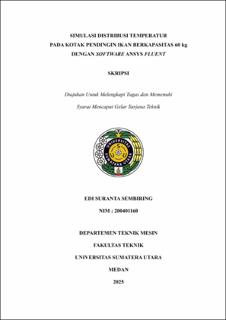| dc.description.abstract | A cooling kotak is a domestic refrigeration system used to store food items such as fish by inhibiting bacterial growth, thereby extending shelf life. Currently, R-134a is a commonly used refrigerant in cooling box, but it poses a significant risk to global warming (GWP = 1430). This study aims to analyze the performance of a 60-kg capacity fish cooling box using R-134a and R-600a refrigerants through Computational Fluid Dynamics (CFD) simulation using ANSYS Fluent. The evaluated parameters include heat absorbed by the evaporator, temperature distribution, and the Coefficient of Performance (COP). The study employed several variables: independent variables included R-134a with a mass flow rate of 0.0136 kg/s, outlet pressure of 512.12 kPa, and evaporator temperatur of -8.6°C; and R-600a with a mass flow rate of 0.0086 kg/s, outlet pressure of 252.25 kPa, and evaporator temperatur of -10.9°C. Dependent variables included the COP of the fish cooling box, evaporator capacity for cooling 60 kg of fish, the effect of temperature distribution on system performance, and a comparative analysis of the effectiveness of R-134a and R-600a. Simulation results show that R-134a yields a higher heat transfer rate of 28,356.62 W and more uniform temperatur distribution (±3.16°C between fish) compared to R-600a (25,819.84 W and ±6°C). This performance is supported by R-134a’s higher density (1.344 kg/m³), which ensures stable refrigerant flow. However, R-600a is environmentally superior with a significantly lower Global Warming Potential (GWP ≈ 3) compared to R-134a and requires less compressor work (0.44 kW versus 0.48 kW for R-134a). Although R-134a achieves a slightly higher COP of 2.45 compared to R-600a’s 2.4, R-600a remains a competitive and eco-friendly alternative. | en_US |


